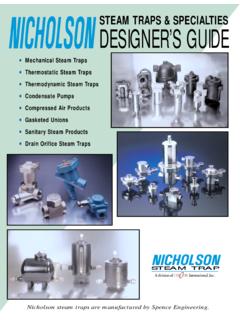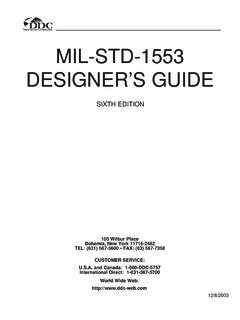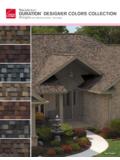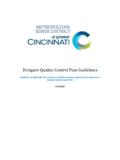Transcription of The Designer’s guiDe To TungsTen CarbiDe
1 The designer s guiDe To TungsTen CarbiDebsteelacarbideCorrosion ResistanceShrink Fit AssemblyBrazing ProceduresTransverse Rupture StrengthYoung's Modulus Of ElasticityEDMWCI ndustrial Adhesives2 THE designer S guiDe TO TungsTen CARBIDEwww. POSSIBLET ungsten CarbiDe Tooling Selection a Click AwayIf you re looking for a better way to determine the TungsTen CarbiDe grade that s right for your specific applications, General CarbiDe can help. Our Grade Selector guiDe is accessible on our web site at guiDe features a step-by-step process that gives you the proper grade selection based on your answers to questions about application parameters and operating using the guiDe , you ll: Simplify the grade selection process Accelerate turnaround times for your customers Maximize wear life of your TungsTen CarbiDe wear parts & toolingGrade Selection Made EasierNOW AVAILABLE!TOOLBOXGENERAL CARBIDED ownload General CarbiDe s Toolbox mobile app from the Google Play Store or Apple App StoreToolbox offers the industry s only grade selector a proprietary tool that easily allows you to choose the best grade for your application.
2 Store your search results in your CarbiDe library for instant access anytime, General CarbiDe s Conversion Calculator to convert pressure, density, mass, length, force and temperature values from English to metric units. The designer s guiDe to TungsTen CarbiDe is your go-to source for the basics of TungsTen CarbiDe tooling from properties to finishing designer S guiDe TO TungsTen CARBIDETMREDEFINING POSSIBLEI ntroduction ..5 Chapter I BackgroundWhat is cemented CarbiDe ? ..6 History ..6 Manufacturing ..8 Chapter II PropertiesMechanical Hardness ..10 Density ..10 Transverse Rupture Strength ..11 Compressive Strength ..13 Impact Strength ..14 Fatigue Strength ..15 Thermal Coefficient of Thermal Expansion ..15 Conductivity ..16 Electrical & Magnetic Electrical Resistance and Conductivity ..16 Magnetic ..16 Corrosion General Properties ..16 Chapter III Design ConsiderationsStress Stress Analysis.
3 18 Weibull s Statistical Strength Theory ..20 Safety Factor ..21 Determination of Failure ..21 Stress Concentrations ..22 Relationship among TRS, and Tensile & Torsional Elevated Temperatures ..24 Corrosive Environments ..24 Table of Contents4 THE designer S guiDe TO TungsTen CARBIDEwww. POSSIBLEC hapter IV Attaching & Assembling of Cemented CarbiDe PartsOverview ..27 Brazing ..28 Bi-metal Thermal Expansion Difference ..28 Relieving Braze Stain ..29 Design Recommendations ..31 Braze Joints ..32 Thickness, Shape ..33 Performance at Various Temperatures ..33 Brazing to Hardened Steel ..34 Brazing Procedures for Cemented CarbiDe ..34 Industrial Adhesives ..36 Thermal Cycling ..37 Recommendations ..37 Interference/Shrink Fit Assembly ..38 General Guidelines ..39 CarbiDe on the Outside Diameter ..41 Press Fits ..41 Mechanical Fastening ..43 Design Rules.
4 43 Methods of Fastening ..44 Internal Threads and V Finishing TechniquesFinishing Grinding ..48 Fundamentals .. 48 Factors ..49 Surface Finishes ..49 Cautions ..50 Recommendations ..50 Electrical Discharge Machining (EDM) ..51 Designing for EDM ..52 Cutting Speed ..53 EDM Limitations ..53 References ..54 Grade Specifications ..55 Conversion Charts ..57 Notes ..58 Table of Contents cont d 5www. designer S guiDe TO TungsTen CARBIDETMREDEFINING POSSIBLEI ntroduction This publication is a reference guiDe for designers, engineers, fabricators and end users of TungsTen CarbiDe material. Specifically, it is a compila-tion of recommendations derived from practical experience, theoretical stress analysis, proven application engineering practices and modern manufacturing techniques. It will enable the reader to gain insights to best practices for using one of the most unique engineering materials available has been said that the tool materials of one generation become the engineering materials of the next generation.
5 This observation is certainly true of TungsTen CarbiDe . It is a material that has been around since the early 1920s, replacing tool steel in most cutting tool applications and developed into an engineering material used to resist the harshest environments of corrosion, high temperature, impact, high compressive loads, deformation and severe abrasion. TungsTen CarbiDe competes with advanced ceramics in the wear parts arena, but just as it did not totally displace tool steel, advanced ceramics can not replace TungsTen CarbiDe . The reason is that TungsTen CarbiDe exhibits superior toughness given its high hardness, which has enabled it to enjoy tremendous growth as a tooling and engineering using this manual, everyone involved in designing with or using TungsTen CarbiDe will have the necessary knowledge for helping to en-sure successful and reliable designs for tooling and wear designer S guiDe TO TungsTen CARBIDEwww.
6 POSSIBLEC hapter I - BackgroundWhat is cemented CarbiDe ? TungsTen CarbiDe (WC), also referred to as cemented CarbiDe , is a composite material manufac-tured by a process called powder metallurgy. TungsTen CarbiDe powder, generally ranging in proportion between 70%-97% of the total weight, is mixed with a binder metal, usually cobalt or nickel, compacted in a die and then sintered in a furnace. The term cemented refers to the TungsTen CarbiDe particles being captured in the metallic binder material and cemented together, forming a metallurgical bond between the TungsTen CarbiDe particles and the binder (WC - Co), in the sintering process. The cemented CarbiDe industry commonly refers to this material as simply CarbiDe , although the terms TungsTen CarbiDe and cemented CarbiDe are used interchangeably. If the permanent deformation of a material at failure is quite small, the material is labeled brittle; if the plastic deformation is very large, the material is called ductile.
7 CarbiDe is classified techni-cally as a brittle material since it exhibits little or no plastic deformation preceding the initiation of a crack and total failure. Without the presence of the metallic binder phase, TungsTen CarbiDe could be considered a ceramic material much the same as silicon CarbiDe or aluminum oxide. The definition of a ceramic material is the marriage of a metal to a nonmetal, for example silicon (metal) CarbiDe (carbon, nonmetal), aluminum (metal) oxide (oxygen, non-metal), or silicon ni-tride. A cermet is a composite material composed of ceramic (cer) and metallic (met) materials. It is the addition of the metallic binder, cobalt or nickel that makes the cemented CarbiDe (WC- Co) a cermet and differentiates it from truly brittle materials, that is, the ceramic family of materials. Cemented CarbiDe is the preferred material for parts that must withstand all forms of wear (including sliding abrasion, erosion, corrosion/wear and metal-to-metal galling) and exhibit a high degree of toughness.
8 It exhibits high compressive strength, resists deflection, and retains its hardness values at high temperatures, a physical property especially useful in metal-cutting applications. It provides long life in applications where other materials would not last or would fail history of cemented carbideSince the late 1800 s when a French chemist, Henri Moissan, first synthesized it, TungsTen CarbiDe has been known as one of the hardest substances in existence, approaching diamond in this respect. In fact, he was seeking to produce man-made diamonds, but WC was the result. Since large solid pieces could not be produced, cast compositions containing TungsTen CarbiDe were tried, but were too brittle and porous for use as an engineered for a substitute to replace the diamond dies employed in drawing TungsTen wire for electric-lamp filaments led the Osram Lamp Works of Berlin to an interesting discovery.
9 Karl Schroeter and Heinrich Baumhauer found that hard CarbiDe , bonded or sintered together with a metal such as cobalt, was not only hard but acquired enough toughness to suggest its use as a cutting tool. The substance discovered by the Osram Company was known as Hartmetall and pointed the way to the development of the modern sintered carbides. Friedrich Krupp, A. G. Essen, acquired the original patent rights and undertook an extensive program culminating in the production of Widia (Wie Diamant, like a diamond), which consisted mainly of TungsTen CarbiDe particles thoroughly interspersed in a cobalt matrix which constituted from 5 to 15% of the total designer S guiDe TO TungsTen CARBIDETMREDEFINING POSSIBLEIn negotiations with Krupp, all American rights accrued to General Electric, with Krupp retaining the right to export Widia to the United States. General Electric formed the Carboloy Company, which sublicensed Firth-Sterling Steel Company and the Ludlum Steel Company.
10 At that time the American equivalents of Widia were known as Carboloy, Dimondite, and Strass Metal. Later, the trade name Dimondite was changed to Firthite. American patent applications were made as early as 1922, but it was not until 1926, after thorough production tests in the Essen workshops, that Krupp marketed Widia TungsTen CarbiDe commercially for the first time in Germany. Tung-sten CarbiDe was expensive, costing about $450 per pound, but even at that price its use could be justified economically. The practice of making only the tool tip out of cemented carbidewas dictated as much by the cost of the material as it was by any other single consideration. Carboloy tools were tested in General Electric plants and came to public attention around the introduction of Widia and its counterparts, Dr. Balke developed a tantalum CarbiDe bonded together with metallic nickel. This material, called Ramet, resisted cratering and proved more successful in machining steel than did TungsTen CarbiDe , which exhibited a tendency toward early cavitation near the cutting edge, where steel chips came into inti-mate contact with the tool face.








